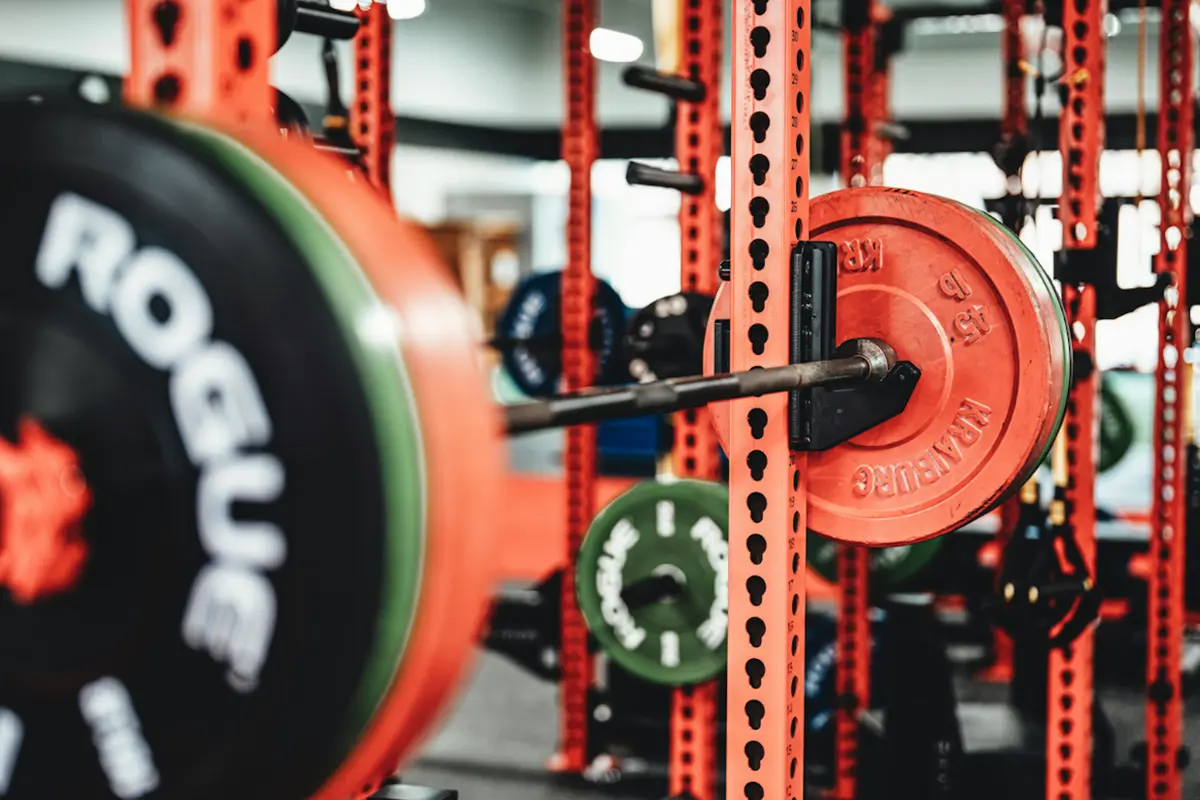Maximal Strength Rep Range Explained

What's In This Article
- Key Highlights
- Introduction
- Defining Maximal Strength
- Understanding Rep Ranges for Strength, Hypertrophy and Endurance
- Maximal Strength Rep Range
- Mistakes to Avoid in Maximal Strength Training
- Conclusion
- Frequently Asked Questions
- REFERENCES AND FURTHER READING
Key Highlights
- The optimal rep range for maximal strength gains is 1-5 reps per set with loads at or above 85% of your one-rep max.
- Maximal strength development relies heavily on neural adaptation, where the central nervous system improves its efficiency in recruiting muscle fibers.
- Rest periods between sets should be 3-5 minutes long to allow proper recovery and maintain performance during heavy lifting.
- Compound lifts like squats, deadlifts, and bench presses are most effective for strength development as they engage multiple muscle groups simultaneously.
- Poor form with heavier weights is counterproductive - a well-executed lift with lighter weight is more effective for strength development than a poorly performed heavy lift.
Introduction
You might wonder why maximal strength is crucial for athletes. Maximal strength is the foundation for many athletic pursuits, from powerlifting and rugby to football and even endurance sports like long-distance running (Suchomel, Nimphius, & Stone, 2016).
Regarding training, various goals may influence the selection of rep ranges.
- If you aim for muscle hypertrophy or size, moderate rep ranges of 8 to 12 reps per set are often recommended (Schoenfeld, Contreras, Krieger, Grgic, Delcastillo, Belliard, & Alto, 2019).
- If your goal is to enhance muscular endurance, higher rep ranges of 15 to 20 reps per set might be more appropriate.
As powerlifting coaches, we spend a lot of time training our lifters in this rep range and intensity, and we understand the benefits and required precautions. Our powerlifters ultimately aim to lift the maximum amount of weight they can.
Defining Maximal Strength
- It is the highest force a muscle or muscle group can generate during a single, all-out effort (Garhammer, 1993). This force is often measured using a one-rep max (1RM), the heaviest weight you can lift for one complete repetition with proper form.
- The central nervous system (CNS) is at the heart of maximal strength development. It sends signals from the brain to the muscles, telling them when and how hard to contract (Enoka, 2008).
- As you train, your CNS adapts by improving the efficiency and speed of these signals. This process, known as neural adaptation, allows you to recruit more muscle fibres and generate greater force during a lift (Aagaard, Simonsen, Andersen, Magnusson, & Dyhre-Poulsen, 2002).
It's important to note that the size of your muscles does not solely determine maximal strength. While a larger muscle generally has a greater potential for producing force, the relationship between muscle mass and strength is not linear.
- Neuromuscular efficiency, or the ability of your CNS to recruit muscle fibres effectively, plays a significant role in determining maximal strength (Folland & Williams, 2007). In other words, two individuals with similar muscle mass may display vastly different levels due to differences in neuromuscular efficiency.
- By understanding the interplay between muscle mass, neuromuscular efficiency, and the central nervous system, you'll be better equipped to develop a training programme that targets maximal strength effectively.

Understanding Rep Ranges for Strength, Hypertrophy and Endurance
When planning your training programme, understanding the impact of various rep ranges on muscle hypertrophy, endurance, and strength is crucial.
- Lower rep ranges (1-5 reps) with heavier loads are recommended for maximal strength development.
- Moderate rep ranges (8-12 reps) with moderate loads are associated with hypertrophic gains or muscle growth (Schoenfeld, 2010).
- Higher rep ranges (15-20 reps) with lighter loads are typically advised for muscular endurance.
- Lighter weight with a higher number of reps can also benefit muscle strength and size, especially when aiming to improve the amount of weight you can lift by the final rep.
A common misconception is that working exclusively in a specific rep range will only yield results related to that range.
- Research indicates that low and high-load resistance training can result in similar increases in muscle size, provided that sets are taken to muscular failure or near-failure (Schoenfeld, Grgic, Ogborn, & Krieger, 2017).
- This means that even when training for maximal strength with lower rep ranges, you can still experience muscle growth alongside your strength gains by taking your sets to muscle failure.
- This is crucial to understanding how to utilize different rep ranges for individual goals.
Note: Training with too much weight and sacrificing form can hinder progress and potentially lead to injury. Finding the right balance between weight and form is crucial to achieve optimal results.
Programming
Pay attention to the importance of intensity, volume, and rest periods when designing your training programme.
- Intensity refers to the load you lift, typically expressed as a percentage of your 1RM. Working with loads of 85% or higher of your 1RM for maximal strength development is generally recommended (Ratamess et al., 2021).
- Volume, which refers to the total amount of work performed (e.g., sets x reps x load), should be adjusted according to your training goals and individual recovery abilities.
- Rest periods allow your muscles and CNS to recover between sets. For maximal training, rest periods of 3-5 minutes between sets are advised to facilitate optimal performance and specific adaptations (de Salles, Simão, Miranda, da Silva Novaes, Lemos, & Willardson, 2009).

Maximal Strength Rep Range
The low-rep, high-intensity approach involves performing 1-5 reps per set with loads at or above 85% of your 1RM (Ratamess et al., 2021). But why is low-rep training so practical for maximal strength?
- The benefits of low-rep training for maximal strength lie in its ability to stimulate neural adaptations and muscle fiber recruitment. By lifting heavy loads, you challenge your CNS to improve the speed and efficiency of muscle fiber recruitment, ultimately enabling you to create more force production (Aagaard et al., 2002).
- Low-rep training has been shown to promote more significant increases in maximal strength compared to higher-rep training, with numerous studies supporting the effectiveness of this approach (e.g., Schoenfeld, 2010; Ratamess et al., 2009).
To Incorporate Low-rep Training into Your Powerlifting Routine, Consider the Following Tips
Appropriate exercise selection:
- Focus on compound lifts, such as squats, deadlifts, bench presses, and rows, as they allow you to lift heavy loads and engage multiple muscle groups simultaneously (Gentil, Fisher, & Steele, 2017).
- These exercises provide the most significant potential for strength development and carryover to athletic performance.
Optimal rest periods and workout frequency:
- Ensure adequate rest between sets (3-5 minutes) to facilitate CNS recovery and maintain performance throughout your workout (de Salles et al., 2009).
- Find a workout frequency that allows sufficient recovery while maintaining consistent progress, typically 2-4 strength-focused sessions per week, depending on your experience and goals.
- Doing heavy sets of at least 4 to 6 sets of 5 (or fewer) reps with 3 minutes of rest in between is recommended.
- For those looking to improve muscular endurance, incorporating higher repetitions with shorter rest periods can also be beneficial.
Progressive overload and periodization strategies:
- Gradually increase your workouts' load, volume, or intensity to challenge your muscles and promote strength gains (Kraemer & Ratamess, 2004).
- Implement periodization strategies, such as linear, undulating, or block periodization, to structure your training programme, manage fatigue, and avoid plateaus (Kiely, 2018).
A popular method to use is linear periodized microcycles:
- Start with lighter weight for higher reps and gradually increase the weight each week until you're down to very heavy weight for low rep counts.
- This method increases muscle strength and endurance, leading to more significant muscle growth.
- This is a method we often coach when tapering a powerlifter into competition.
Undulating periodization varies in intensity and volume within each week rather than progressing linearly:
- Athletes alternate between heavy, medium, and light days each week, allowing frequent exposure to various rep ranges.
- This method prevents staleness and maintains consistent neural adaptations through frequent heavy loading.
- Advanced lifters often use this approach as it enables more frequent maximal effort training while managing fatigue through strategic light days.
Individual variation and personal preferences play a role in training success, so don't be afraid to experiment and find what works best for you.

Mistakes to Avoid in Maximal Strength Training
Neglecting proper warm-up and mobility work:
- Warming up before your training sessions is essential for preparing your muscles, joints, and CNS for the work ahead (McGowan, Pyne, Thompson, & Rattray, 2015).
- Dedicate time to perform dynamic stretches and movements that mimic the exercises in your workout. This will improve your performance and help reduce the risk of injury.
- Remember to incorporate regular mobility work into your routine, as it can enhance your range of motion and overall training efficiency (Page, 2012).
Ignoring technique and form in pursuit of heavier loads:
- While lifting heavy weights is a vital component of maximal strength training, it should never come at the expense of proper technique and form (Schoenfeld & Grgic, 2020).
- Lifting with poor form can lead to imbalances, chronic injuries, and limited progress.
- Ensure that you prioritize learning and maintaining the correct form for each exercise, even if it means reducing the weight temporarily.
- A well-executed lift with a lighter load is far more effective for strength development than a poorly performed lift with a heavier load.
Overtraining and failing to allow sufficient rest and recovery:
- It's easy to fall into the trap of overtraining, believing that "more is always better." However, excessive training without adequate rest and recovery can lead to diminished performance, increased injury risk, and even regression in gains (Kreher & Schwartz, 2012).
- Listen to your body and allow sufficient time for rest and recovery, including rest days, deload weeks, and sleep. This will improve your performance and enhance your overall well-being.
Conclusion
Doing low-rep, high-intensity exercises is the best way to build maximal strength. This means doing 1-5 reps with heavy weights, at least 85% of your max.
Being consistent, patient, and adjusting to your needs is key to success in training. Results don't come instantly; it takes time. Stick to your training program, trust it, and change if needed.
Contact our experienced coaches at Sportive Tricks for questions, programming and in-depth technique analysis.
Frequently Asked Questions
How often should I train for maximal strength?
2-4 times per week, depending on experience level and recovery ability.
Can I build muscle with low reps?
Low-rep training can build muscle when sets are taken close to failure.
How heavy should the weight be?
At least 85% of your one-rep max for maximal strength development.
Do I need special equipment for maximal strength training?
Basic barbell equipment is sufficient. Focus on quality squat racks, barbells, and weight plates.
REFERENCES AND FURTHER READING
- Aagaard, P., Simonsen, E. B., Andersen, J. L., Magnusson, P., & Dyhre-Poulsen, P. (2002). Increased rate of force development and neural drive of human skeletal muscle following resistance training. Journal of Applied Physiology, 93(4), 1318-1326. https://doi.org/10.1152/japplphysiol.00283.2002
- de Salles, B. F., Simão, R., Miranda, F., da Silva Novaes, J., Lemos, A., & Willardson, J. M. (2009). Rest interval between sets in strength training. Sports Medicine, 39(9), 765-777. https://doi.org/10.2165/11315230-000000000-00000
- Enoka, R. M. (2008). Neuromechanics of human movement. Human Kinetics.
- Folland, J. P., & Williams, A. G. (2007). The adaptations to strength training: Morphological and neurological contributions to increased strength. Sports Medicine, 37(2), 145–168. https://doi.org/10.2165/00007256-200737020-00004
- Garhammer, J. (1993). A review of power output studies of Olympic and powerlifting: Methodology, performance prediction, and evaluation tests. Journal of Strength and Conditioning Research, 7(2), 76–89. https://journals.lww.com/nsca-jscr
- Gentil, P., Fisher, J., & Steele, J. (2017). A review of the acute effects and long-term adaptations of single- and multi-joint exercises during resistance training. Sports Medicine, 47(5), 843–855. https://doi.org/10.1007/s40279-016-0627-5
- Kiely, J. (2018). Periodization theory: Confronting an inconvenient truth. Sports Medicine, 48(4), 753–764. https://doi.org/10.1007/s40279-017-0823-y
- Kraemer, W. J., & Ratamess, N. A. (2004). Fundamentals of resistance training: Progression and exercise prescription. Medicine & Science in Sports & Exercise, 36(4), 674-688. https://doi.org/10.1249/01.MSS.0000121945.36635.61
- Kreher, J. B., & Schwartz, J. B. (2012). Overtraining syndrome: A practical guide. Sports Health, 4(2), 128-138. https://doi.org/10.1177/1941738111434406
- McGowan, C. J., Pyne, D. B., Thompson, K. G., & Rattray, B. (2015). Warm-up strategies for sport and exercise: Mechanisms and applications. Sports Medicine, 45(11), 1523–1546. https://doi.org/10.1007/s40279-015-0376-x
- Page, P. (2012). Current concepts in muscle stretching for exercise and rehabilitation. International Journal of Sports Physical Therapy, 7(1), 109–119. https://pmc.ncbi.nlm.nih.gov/articles
- Ratamess, N. (2021). ACSM's foundations of strength training and conditioning (2nd ed.). Wolters Kluwer Health.